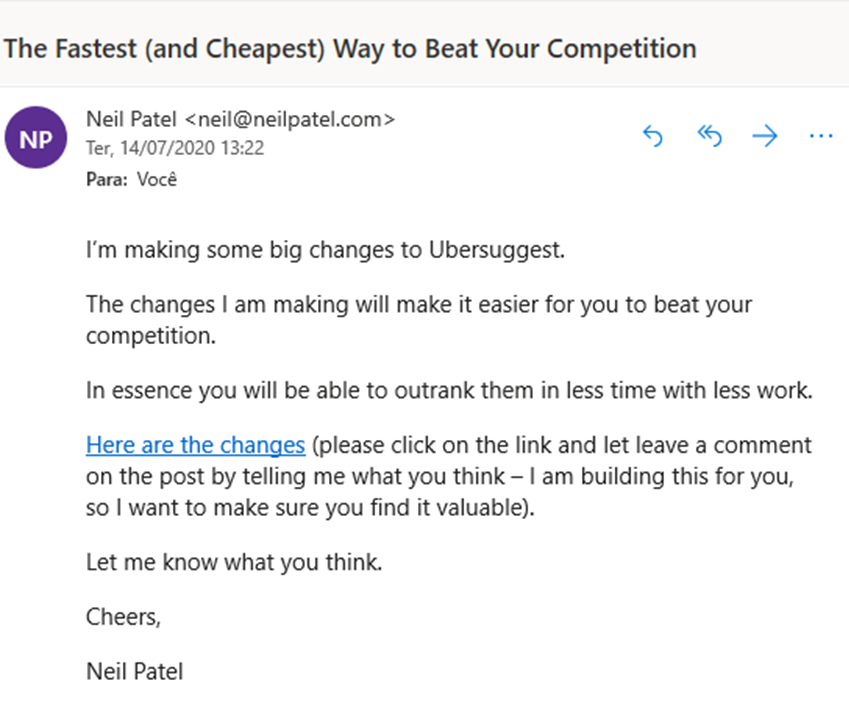Get to the point and know how to sell
Among marketing channels, e-mails offer one of the most significant ROI: $38 for every $1 spent. Whether you are a writer developing your audience, a company that wants to have a better relationship with the customer, or a marketer promoting a product, e-mails need to be part of your content strategy. It got me thinking: What makes an e-mail useful? Why do I open it? Which ones do I read from top to bottom?
Neil Patel is one of the most significant online marketing authorities, and his content focuses mainly on SEO. I subscribed to his e-mail list years ago. It’s not a newsletter, but a channel through which Neil shares his content and promotes his products.
Take a look at one of his most recent e-mails:

If you want to learn how to write effective e-mails, here are some takeaways from Neil Patel:
Context
Why are you sending this e-mail right now? Answering this question provides context to your e-mail. Whether it’s a new update of your product, an article you would like to share, or a special offer. Neil’s e-mail has a precise context:
“I’m making some significant changes to Ubersuggest.”
Ubersggest is Neil Patel’s product: a chrome extension that offers SEO insights. Among its features, it shows SEO metrics and gives keyword recommendations.
Context gives a sense of purpose to your message and prevents it from being random. With the new update to the product, Neil has a proper context. For current customers, they want to know which new features are available. As for prospective customers, the update may finally convince them to buy it.
Subject
Like the title of an article, the subject of an e-mail has a significant impact on the open rate. Take a look at Neil’s subject:
“The Fastest (and Cheapest) Way to Beat Your Competition”
Length: 55 characters with space.
Benefit: Right from the start, it shows a clear advantage for the reader: beat the competition.
Superlative: Neil is not afraid of making big promises, Fastest and Cheapest.
Title case: The subject is in title case.
The Benefit
The primary purpose of an e-mail is to convince someone to do something. To achieve this, keep the following questions in mind: what will the person get from making this action? What value does the e-mail provide to my reader? Neil’s e-mail has a clear value proposition. It is by far the most substantial part of Neil’s e-mail:
“The changes I am making will make it easier for you to beat your competition.
In essence, you will be able to outrank them in less time with less work.”
The benefit is crystal clear: to more results with less work. It is a powerful promise, which appeals to most marketers. Here’s how to use e-mails to highlight your product’s benefits.
Focus: Neil chose only one benefit per e-mail.
Concise: deliver the message in two sentences.
Use emotions: Neil appeals to our competitive instincts when he promises to beat the competitors.
Call-To-Action
Every valid e-mail has a clear call-to-action. Don’t ever assume the customer will click on your link, buy your product, or comment on your post. It’s your job to tell the customer what to do. Neil makes excellent calls-to-action. He spent 50% of his e-mail (40 out of 80 words) writing compelling instructions:
“Here are the changes (please click and leave a comment on the post by telling me what you think — I am building this for you, so I want to make sure you find it valuable).
Let me know what you think.”
It has most elements of an impressive call-to-action:
Link in the beginning.
Personalization: By saying, “I am building this for you,” Neil makes the reader feel appreciated. It sends the message that their opinion matters.
Clear instructions: The e-mail tells the user precisely what to do: “click on the link and leave a comment.”
Length
Neil kept the e-mail concise, he delivers the message in 80 words. Without the title and the greetings, the entire message has only five sentences. These are the two benefits of keeping the e-mail short:
The customer has a clarity of the message.
It’s easier for the recipient to read from top to bottom.
E-mails are compelling if used correctly. As one of the major authorities in online marketing, Neil Patel writes concise and practical e-mails to engage his audience. These are his lessons: have a context, know the benefit you offer, keep it brief, work on the subject, and write a killer call-to-action.
Article originally published to Medium
Written by Laura Kreuz
